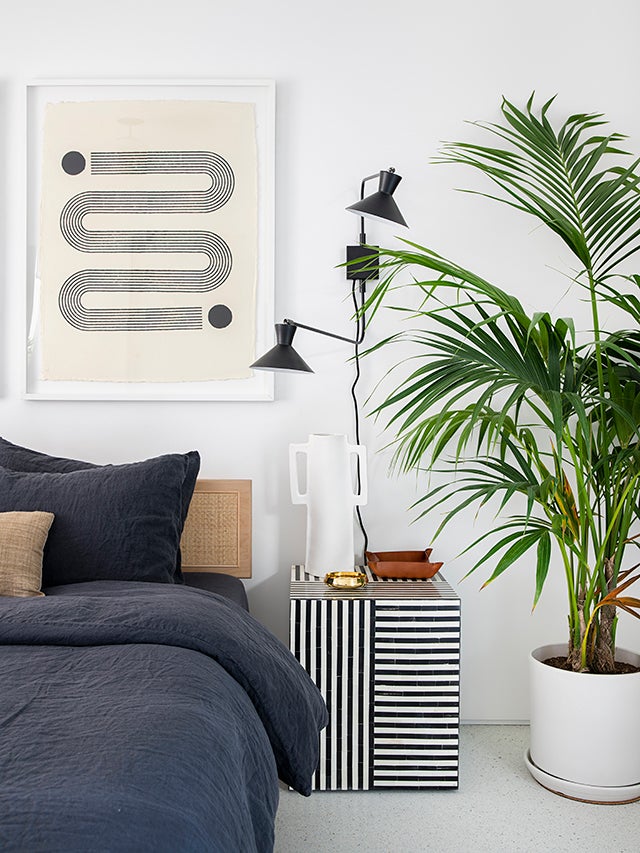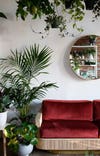If You Want That $400 Ficus to Live, Hire a Plant Stylist
Like a house call for your succulents.
Updated Oct 12, 2018 1:31 AM
We may earn revenue from the products available on this page and participate in affiliate programs.
Hiring a green goddess to come outfit your space with leafy, growing things may seem like an indulgence, but an expert eye and tips that will set you up in a long-term relationship with, say, a Chinese money plant may be worth the expense. “I don’t believe in the concept of a green thumb or a black thumb,” says Danae Horst, owner of the rustic-modern plant boutique Folia Collective, whose clients include Mandy Moore. “If your plants always die on you, you’re just picking the wrong plant or getting bad advice. You have to be realistic about what plants need and what you can offer them. It’s like matchmaking.”
At Horst’s shop in Los Angeles’s Eagle Rock neighborhood, customers get more than just a pot of dirt with something growing inside of it. They get her expertise in the form of healthy, handpicked plants from a reliable grower; detailed directions for care; and, more important, her plant stylist know-how. What is a plant stylist, you ask? A person who can scan a room, assess the light exposure and the direction its windows are facing, size up the decor, and make recommendations to transform a lifeless space into a living, breathing home, where a grown-up who remembers to water things lives. The key word is breathing: Indoor plants produce oxygen, and there is ample proof that some plants remove allergens and toxins, like toluene and formaldehyde, from the air.
Horst’s services range from the simple—a client comes into the store with photos of their house, they discuss lifestyle and pets (some foliage is toxic to animals), and Horst recommends a plant scheme—to the full “green glove” treatment, in which she goes to your home and handles the entire process, from design to installation. (Any specialty plant store might be willing to offer this service. And a handful of online shops, like Léon and George in San Francisco and Bloomscape in Detroit, offer online consultations and ship house plants—prepotted in chic and simple containers—nationwide.)
Here, Horst breaks down the basics of growing, caring for, and curating the ultimate mix of happy houseplants.
Don’t Fall Prey to Pinterest
Plants are one area where following trends is not advised. “The fiddle-leaf fig is a good example,” Horst says, noting that while the big, sculptural leaves make it Instagram worthy, it’s not a great plant for beginners. It requires careful watering, bright but filtered light, and warmer year-round temperatures. If you travel a lot, or your light and climate aren’t ideal, a large monstera, an elephant-ear plant, or the extra durable sansevieria (aka snake plant) might be a better choice. Ferns are having a moment, especially in misty bathrooms, but they’re a hassle to maintain in a dry climate. “If you want to get trendy, do it with the containers,” says Horst, who adds that simple clay cylindrical pots, always with a drainage hole if you want a plant to live, are both of the moment and timeless.
Group Plants in Clusters of Three or Five
On the top of a bookshelf, assembled in the corner of a dining room or inside the hearth of an unused fireplace, groups of plants (most appealing in odd numbers to maintain an interesting balance) create a humid little microclimate and also filter more airborne allergens and chemicals. Horst suggests a variety of heights and leaf shapes, such as waxy/feathery/spiky, and color groupings.
Get the Right Tools
Every Folia customer is advised to invest in a moisture meter for $8 and a one-size-fits-all fertilizer. A meter is more reliable than the finger test in determining whether a plant is ready for water. And fertilizer replenishes nutrients. Some houseplant whisperers sing the praises of “set it and forget it” time-released fertilizer granules, which last up to six months (not stakes, which can burn a plant’s roots). Horst recommends a tiny bit of diluted fertilizer, like Good Dirt—which is made from plant-seed extracts, not synthetics—every time you water a plant. Pro tip: Don’t apply fertilizer directly to dry soil. Water first; feed later.
Suspend Those Leafs
Sometimes you think a bare corner is begging for a large, sculptural tree (see: fiddle-leaf fig), but what it really needs is height, which can also be achieved with a less-expensive, lower-commitment hanging plant, such as a pothos or a trailing vine. “Plants hanging from a ceiling are such an easy way to add a pop of color and visual interest,” says Horst. Keep a step stool for watering handy.
See more plant-care tips: Is This the Next Monstera? How to Make This Tropical Plant Thrive This Popular Household Plant Is Virtually Impossible to Kill, Says an Expert How to Care for Succulents (and Other Low-Key Plants)

